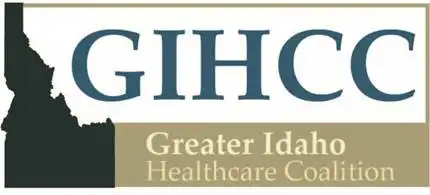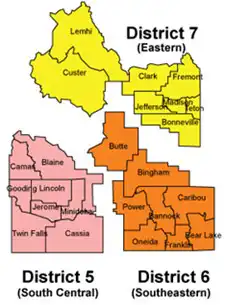Greater Idaho Healthcare Coalition
The Department of Health and Human Services (DHHS) administers the Assistant Secretary for Preparedness and Response (ASPR) Healthcare Preparedness Program (HPP) grant to the State of Idaho Department of Health and Welfare. The mission of this grant is "to ready hospitals and supporting health care systems to deliver coordinated and effective care to victims of terrorism and other public health emergencies." The region consists of the following: Shoshone-Bannock Tribal agencies, as well as Bannock, Bear Lake, Bingham, Butte, Caribou, Franklin, Oneida, and Power counties.
The Healthcare Preparedness Program (HPP) enhances the ability of hospitals and health care systems to prepare for and respond to bioterrorism and other public health emergencies. Current program priority areas include interoperable communication systems, bed tracking, personnel management, fatality management planning and hospital evacuation planning. During the past five years HPP funds have also improved bed and personnel surge capacity, decontamination capabilities, isolation capacity, pharmaceutical supplies, training, education, drills and exercises. Hospitals, outpatient facilities, health centers, EMS and other healthcare partners work with the appropriate state or local health department to acquire funding and develop healthcare system preparedness through this program. Funding is distributed directly to the Idaho Department of Health and Welfare to Southeastern Idaho Public Health, who in turn works with healthcare entities.
The HPP supports priorities established by the National Preparedness Goal established by the Department of Homeland Security (DHS) in 2005. The Goal guides entities at all levels of government in the development and maintenance of capabilities to prevent, protect against, respond to, and recover from major events, including Incidents of National Significance. Additionally, the Goal will assist entities at all levels of government in the development and maintenance of the capabilities to identify, prioritize and protect critical infrastructure The Pandemic and All Hazards Preparedness Act of 2006 transferred the National Bioterrorism Hospital Preparedness Program (NBHPP) from the Health Resources and Services Administration to the Assistant Secretary for Preparedness and Response (ASPR). The focus of the program is now all-hazards preparedness and not solely bioterrorism.
Program Priorities
- Foundation for Health Care and Medical Readiness
- Health Care and Medical Response Coordination
- Continuity of Health Care Service Delivery
- Medical Surge
Capabilities-based planning is defined as, "planning, under uncertainty, to provide capabilities suitable for a wide range of threats and hazards while working within an economic framework that necessitates prioritization and choice." This planning approach assists leaders at all levels to allocate resources systematically to close capability gaps, thereby enhancing the effectiveness of preparedness efforts. Capabilities-based planning will provide a means for the Nation to achieve the Goal and National Priorities by answering three fundamental questions: "How prepared do we need to be?", "How prepared are we?", and "How do we prioritize efforts to close the gap?"

- To provide a forum for hospital, healthcare, emergency response, and essential community partners committed to building and sustaining a regional healthcare response system to emergency, preparedness, response, and recovery.
- To build, coordinate, and improve medical surge capabilities and capacities for healthcare entities responding to bioterrorism, infectious disease outbreaks, natural or man-made disasters, and other public health threats and emergencies.
- Maintain a common operating picture during a response through timely and efficient sharing of essential elements of information using pre-determined communication pathways and technologies.
- Ensuring overall readiness through day-to-day situational awareness as well as coordination of community-wide training and exercises.
- Promote preparedness in the healthcare community through standardized practices and integration with other response partners.
For more information about the Healthcare Preparedness Program or Health Care Coalitions, please view the following video.
The mission of the Coalition is to serve community healthcare preparedness through coordination, collaboration, and communication in order to effectively manage resources, assets, and personnel throughout south-central, southeastern, and eastern Idaho. The coalition is organized in and serves twenty-four counties and two tribes in south-central, southeastern, and eastern Idaho. For more information on the Greater Idaho Healthcare Coalition, please contact the Regional Readiness Coordinator, Heather Flaherty, at 208-239-1057.


